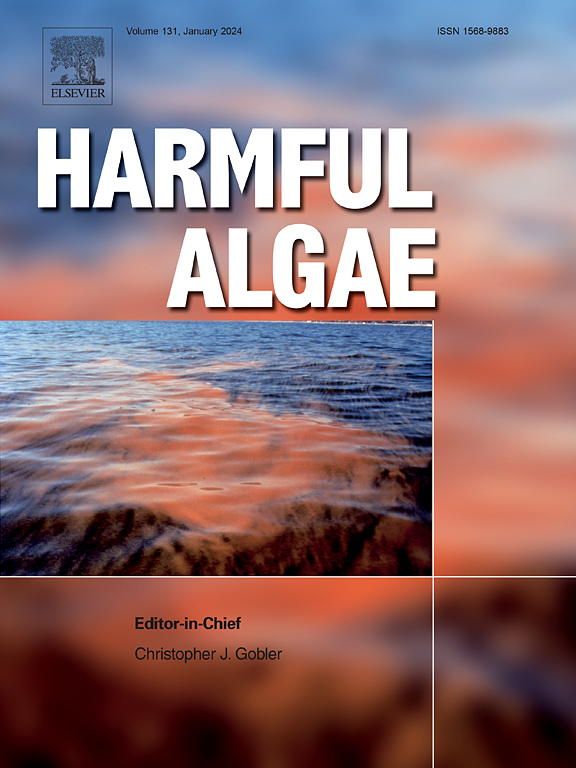环境水平的抗生素破坏微囊藻的化学计量:在蓝藻有害藻华的背景下被忽视的风险
IF 4.5
1区 生物学
Q1 MARINE & FRESHWATER BIOLOGY
引用次数: 0
摘要
在微量水平(纳克至微克每升,ng L-1 - μg L-1),抗生素对蓝藻产生刺激作用,可能对水生生态系统构成威胁。本研究首次观察到与环境相关的抗生素浓度会破坏微囊蓝藻的化学计量(即碳(C)、氮(N)和磷(P)的配额和分配模式)。在抗生素剂量为50至200 ng L-1的情况下,蓝藻表现出复杂的反应——细胞内P库减少22%至24%,元素分配模式调整,例如C:P的比例增加51%。此外,在这些剂量下,抗生素显著影响了蓝藻的生理,导致细胞外聚合物物质(EPS)的产量增加,最大生物量大幅增加(增加169%至219%),菌落大小扩大(增加22%至37%)。转录组学分析显示,这些变化与ABC转运蛋白的下调以及光合作用和核糖体过程的上调有关。这项研究为蓝藻和华花形成的激效效应提供了新的见解,强调了使用多维评估框架的必要性,该框架整合了综合华花因子(生物量,菌落大小和EPS)和元素概况(C, N和P配额和比率)以进行准确评估。本文章由计算机程序翻译,如有差异,请以英文原文为准。

Environmental-level antibiotics disrupt Microcystis stoichiometry: An overlooked risk in the context of cyanobacterial harmful algal blooms
At trace levels (nanograms to micrograms per liter, ng L-1 – μg L-1), antibiotics exert stimulatory effects on cyanobacteria, potentially posing a threat to aquatic ecosystems. Here, environmentally relevant concentrations of antibiotics were firstly observed to disrupt the stoichiometry of cyanobacterium Microcystis (i.e., the quota and allocation patterns of carbon (C), nitrogen (N), and phosphorus (P)). In scenarios where the doses of antibiotics ranged from 50 to 200 ng L-1, cyanobacteria displayed a complex response – a reduction of their intracellular P pools by 22% to 24% and an adjustment of elemental allocation patterns, such as by a 51% increase in the ratio of C:P. Furthermore, at these doses, antibiotics significantly impacted the physiology of cyanobacteria, resulting in increased production of extracellular polymeric substances (EPS), a substantial rise in maximum biomass (169% to 219% increase), and an enlargement of colony size (22% to 37% increase). Transcriptomic analyses revealed that these changes were linked to the downregulation of ABC transporters and the upregulation of photosynthetic and ribosomal processes. This research offers novel insights into the hormesis effects on cyanobacteria and bloom formation, highlighting the necessity of using a multidimensional evaluation framework that integrates comprehensive bloom factors (biomass, colony size, and EPS) and elemental profiles (C, N, and P quotas and ratios) for accurate assessment.
求助全文
通过发布文献求助,成功后即可免费获取论文全文。
去求助
来源期刊

Harmful Algae
生物-海洋与淡水生物学
CiteScore
12.50
自引率
15.20%
发文量
122
审稿时长
7.5 months
期刊介绍:
This journal provides a forum to promote knowledge of harmful microalgae and macroalgae, including cyanobacteria, as well as monitoring, management and control of these organisms.
 求助内容:
求助内容: 应助结果提醒方式:
应助结果提醒方式:


